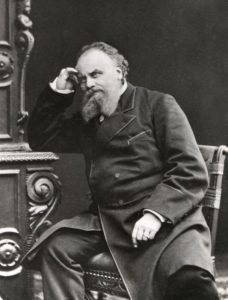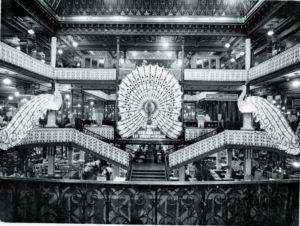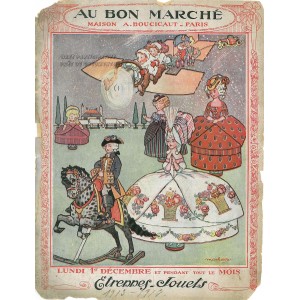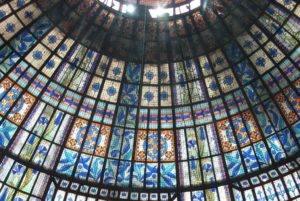By Rachel Mesch (Regular Contributor)
When counting up the various revolutions that shook nineteenth-century France,  we should not neglect the quiet one that took place in 1852 when the ambitious young merchant Aristide Boucicaut joined his shop with that of a colleague. It was the first step towards the invention of the department store, and with it, the explosion of consumer culture itself.
we should not neglect the quiet one that took place in 1852 when the ambitious young merchant Aristide Boucicaut joined his shop with that of a colleague. It was the first step towards the invention of the department store, and with it, the explosion of consumer culture itself.

Aristide Boucicaut. You can make out his “bosse de commerce” just above the hand against his head.
Before Boucicaut thought to house as many different kinds of items as possible under one roof, French consumers would go to a specialized store for each purchase. But with the new one-stop shopping of Le Bon Marché—Boucicaut’s “grand magasin” (the French word for department store is literally “big store”)—consumers began to purchase not just what they had come to the store in search of, but what happened to catch their eye along the way. Less expensive items strategically—and aesthetically–placed towards the entrance drew people in; women’s fashions were hidden on upper floors, coaxing motivated shoppers to make their way through the labyrinthine layout, and invariably finding new must-have treasures along the way. The impulse purchase was born. Boucicaut bought in bulk and cut prices to thwart his competitors. Profit margins soared.
What’s more, rather than picking out fabrics and ordering clothing based on designs, for the first time customers could browse and touch the pieces, prêt-à-porter, ready to wear, trying them on so that they could then be altered to fit. No longer were buyers subject to prices that fluctuated at the whim of the seller. The tags were now posted, and the prix fixe meant one price for all.

Le Bon Marché in 1892
Emile Zola – who studied Boucicaut’s store as one might a new species—described all this as the “democratization of luxury.” And this aspect in itself was its own sort of revolution, really, for if everyone could buy the same dress, how was one to tell the difference between an upper bourgeois chic Parisienne and a high class courtesan? The department store went a long way towards effacing the visible differences in social classes, making it possible for anyone with enough cash on hand to dress the part they wished to play.
It would be hard to exaggerate the extent of this seismic shift in consumer culture. The brilliant Boucicaut took his store from a small mom and pop business to a staggering new form of commerce. Eventually employing nearly two thousand employees and raking in over seventy million francs a year, Le Bon Marché grew and grew. In the 1860s, Boucicaut hired Gustave Eiffel’s team (long before the tower was to bear his name) to build a giant new store—

1929 photo inside Le Bon Marché, courtesy of Marie Odile Radom
which had to be expanded even further midway—and which took nearly fifteen years to complete. It’s no wonder that Zola described the store as a machine, a cathedral, a monster with a life of its own. “A whole world was burgeoning there,” he writes, “in the echoing life between the high metal naves” (231).

1913 Christmas catalog
We can thank Boucicaut—whose bumpy forehead eventually became an idiom for business acumen in French—for pretty much every trick in the consumer culture book. Huge mark-downs to get you in the door? That was him. Prizes for kids to keep them distracted while the moms spent their money? Him too.
The white sale to encourage shoppers to spend money during the slow season? Advertising? Coupons? All of these started in Le Bon Marché. He also launched the first mail order catalog—issuing thousands of copies in multiple languages– so that you could literally shop from anywhere in the world.

The cupola of Le Printemps
One sign of Boucicaut’s success was his competition: in 1865, Jules Jaluzot opened Le Printemps, purposefully located in a still under-developed neighborhood near the Gare St Lazare. Jaluzot’s gorgeous structure– with its soaring stained glass cupola — soon invited enormous crowds to flow directly into Paris’s “cathedral of modern trade” (231) through the convenience of public transportation. “If he had known how,” wrote Zola in his fictionalized version, “he would have made the street run through his shop” (233). Matching Boucicaut’s ingenuity, Jaluzot launched the enduring end-of-season sale, and grasped the psychological potential of advertising: on the first day of spring, the store offered a bouquet of violets to those who visited—so that through this floral namesake, customers brought subliminal reminders of the store home with them along with their purchases.
The next time you flip through a catalogue, try on a dress, or come out of a store having bought something you did not go in there to purchase, you can think of the French man with the bump on his forehead and remember that –like so many aspects of modern consumer culture—it all started in nineteenth-century Paris.
Further reading:
Heidi Brevik-Zender, Mode and Modernity: Fashioning Space in Late Nineteenth-Century (University of Toronto Press, 2015).
Michael Miller, The Bon Marché: Bourgeois Culture and the Department Store, 1869-1920 (Princeton University Press, 2014).
Emile Zola, The Ladies’ Paradise (Au bonheur des dames, 1883). (Oxford World Classics, 2008).
